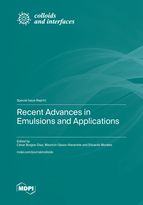Recent Advances in Emulsions and Applications
A special issue of Colloids and Interfaces (ISSN 2504-5377).
Deadline for manuscript submissions: closed (30 April 2023) | Viewed by 41489
Special Issue Editors
Interests: emulsions science; encapsulation; delivery systems; bioactive compounds; emulsifiers; food science
Special Issues, Collections and Topics in MDPI journals
Interests: food structuring; plant proteins; bioavailability; bioaccessibility
Special Issues, Collections and Topics in MDPI journals
Special Issue Information
Dear Colleagues,
Emulsion science and technology have been used for a long time to create a wide variety of commercial emulsified products, including food, pharmaceutical, and cosmetic products. Moreover, this type of colloidal system has been used as a vehicle for the encapsulation and delivery of different bioactive compounds, such as antioxidants, vitamins, and fragrances. In the last several years, there have been advances in emulsion science to improve the quality and performance of different emulsion-based products using new techniques and structural design. This new generation of advanced emulsions may lead to products with improved quality and functionality. Therefore, we invite all researchers in the area to contribute to this Special Issue by submitting reviews or original articles. Manuscripts addressing recent advances in the creation of novel emulsion systems are welcome. The development and application of advanced emulsion technologies are considered for this Special Issue. In this context, contributions focused on emulsions stabilized by particle-based emulsifiers (Pickering emulsions), high-internal-phase emulsions, multilayer emulsions, nanoemulsions, multiple emulsions, emulgels, oleogel-based emulsions, bigels, water-in-water emulsions, and novel emulsifiers will be considered. Manuscripts on recent advances in emulsion-based delivery and encapsulation approaches are also welcome.
Dr. César Burgos-Díaz
Dr. Mauricio Opazo-Navarrete
Dr. Eduardo Morales
Guest Editors
Manuscript Submission Information
Manuscripts should be submitted online at www.mdpi.com by registering and logging in to this website. Once you are registered, click here to go to the submission form. Manuscripts can be submitted until the deadline. All submissions that pass pre-check are peer-reviewed. Accepted papers will be published continuously in the journal (as soon as accepted) and will be listed together on the special issue website. Research articles, review articles as well as short communications are invited. For planned papers, a title and short abstract (about 100 words) can be sent to the Editorial Office for announcement on this website.
Submitted manuscripts should not have been published previously, nor be under consideration for publication elsewhere (except conference proceedings papers). All manuscripts are thoroughly refereed through a single-blind peer-review process. A guide for authors and other relevant information for submission of manuscripts is available on the Instructions for Authors page. Colloids and Interfaces is an international peer-reviewed open access semimonthly journal published by MDPI.
Please visit the Instructions for Authors page before submitting a manuscript. The Article Processing Charge (APC) for publication in this open access journal is 1600 CHF (Swiss Francs). Submitted papers should be well formatted and use good English. Authors may use MDPI's English editing service prior to publication or during author revisions.
Keywords
- emulsion science
- delivery systems
- nanoemulsions
- encapsulation
- emulsion technology
- emulsion applications
- emulsion structure
- advances in emulsion systems
- emulgels
- oleogel-based emulsions
- novel emulsifiers








